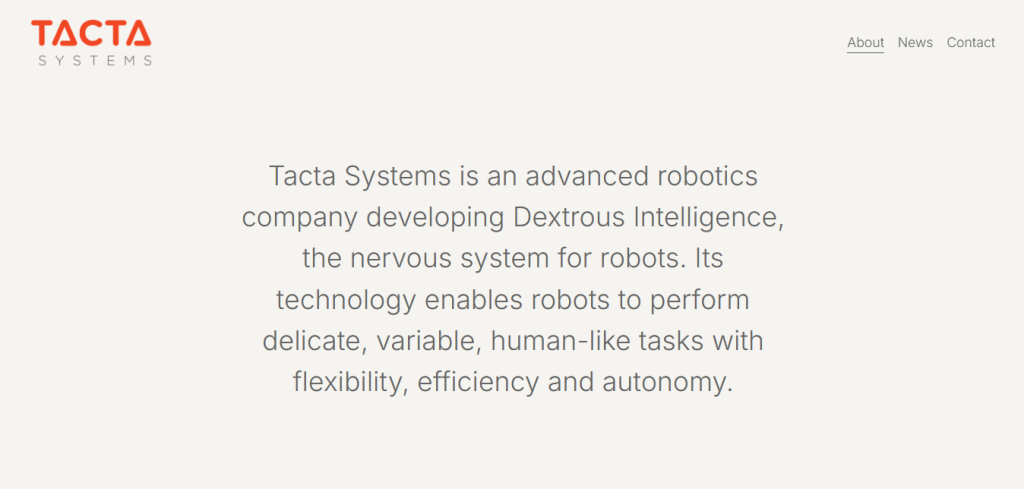
Tacta Systems, an advanced robotics company developing “Dextrous Intelligence,” has announced a successful $7 million funding round, drawing attention from some of the world’s most forward-looking investors. The round includes backing from Matter Venture Partners, America’s Frontier Fund, SBVA, B Capital, EDBI, Sojitz Corporation, Yazaki Innovations, B5 Capital, Tyche Partners, and Woven Capital, among others.
Led by CEO Andreas Bibl, Tacta Systems is redefining how robots interact with the physical world - by giving them something they've historically lacked: a nervous system.
A New Frontier in Robotics: Dextrous Intelligence
At the heart of Tacta Systems’ innovation is Dextrous Intelligence, a proprietary approach that enables robots to perform highly variable, human-like tasks with autonomy, flexibility, and precision. Rather than relying on rigid, pre-programmed movements, Tacta’s technology allows machines to adapt in real time - just like humans do when grasping a delicate object, threading a wire, or assembling a small component.
In short, this is robotics with feeling. While traditional robotics excels in controlled environments like assembly lines, Tacta is pushing the boundary by allowing robots to function in dynamic, unpredictable settings. That opens new possibilities in logistics, eldercare, precision manufacturing, surgical robotics, and beyond.
Why This Matters Now
The robotics industry is approaching a pivotal transformation. According to the International Federation of Robotics (IFR), over 3.9 million industrial robots are operating worldwide - a figure expected to climb significantly as automation demand increases. Global robotics spending is projected to reach $258 billion by 2027, with a compound annual growth rate (CAGR) of 15.8%.
However, traditional robotics solutions are still limited in environments that require dexterity, soft-touch sensing, or nuanced manipulation. Tacta Systems directly addresses this unmet need.
And here's the ultra insight that should make every founder stop and rethink their go-to-market strategy: Tacta isn’t trying to own the robot - they’re trying to own what makes the robot human. That’s a massive difference. It means instead of competing in the crowded, capital-intensive world of full-stack robotics, they’re building the enabling layer that every other robotics company will need.
This is how moats are built in deep tech: not by replicating hardware, but by owning the intelligence layer - the nervous system - that makes the hardware useful across domains. Founders should take note: when you build a solution that unlocks value across other platforms, you don’t compete - you become infrastructure. And infrastructure commands leverage.
Where the New Funding Will Go
With $7 million in fresh capital, Tacta Systems plans to:
- Scale its engineering and R&D teams, particularly in sensor integration, AI decision layers, and human-machine interaction models
- Accelerate partnerships with strategic manufacturing and logistics partners to pilot real-world applications
- Expand production capabilities for its proprietary hardware-software nervous system platform
The company also hinted at launching its first commercial robotic module powered by Dextrous Intelligence within the next 12 months.
What Founders Can Learn From Tacta’s Strategy
Here’s a powerful insight buried in Tacta’s approach: The next wave of robotic disruption won’t come from building more robots - it’ll come from making existing robots smarter, more adaptable, and more human-aware.
Tacta didn’t start by competing head-to-head with Boston Dynamics or Fanuc. Instead, it built a core intelligence layer - a drop-in nervous system - that can elevate a wide range of robotic platforms. This modular, system-agnostic approach means faster integration, lower development costs, and greater scalability.
For founders in hard tech: building a layer that unlocks new capabilities in existing infrastructure can be more defensible and scalable than building from scratch. It’s not just about the robot - it’s about what powers the hands, the feedback loops, the reflexes.
And more importantly: Deep tech products don't need to feel abstract. Tacta is solving an incredibly complex challenge, but they framed it simply - “We’re giving robots a nervous system.” That clarity of narrative is a growth weapon, especially when communicating with investors, media, and customers.
The Industry Outlook: Soft Robotics, AI, and Human-Machine Symbiosis
Tacta Systems sits at the intersection of several fast-growing markets:
- Robotics: The global robotics market is expected to surpass $200 billion by 2030, according to Allied Market Research.
- Tactile sensing & AI control systems: These technologies are forecasted to grow at a CAGR of over 18%, driven by demand in precision industries like electronics, aerospace, and healthcare.
- Human-assistive automation: As the global population ages, demand for dexterous robots in healthcare, rehabilitation, and elderly care is surging - projected to reach $25 billion by 2028.
Major corporations like Amazon, Toyota, and Medtronic have already made aggressive bets on tactile intelligence and dexterous robotics. With this momentum, Tacta is well-positioned to become a key enabler in this new wave of robotic-human interaction.
What’s Next for Tacta Systems
As Tacta moves toward commercialization, the company is expected to announce pilot partnerships across manufacturing and logistics, as well as an expansion of its tactile AI development platform. Its near-term goal: enable robots to handle non-repetitive, high-variance tasks with confidence and safety.
With backing from global venture firms and strategic industrial players, Tacta Systems is no longer just building a robotic nervous system - it’s becoming a critical nervous system for the future of work itself.









